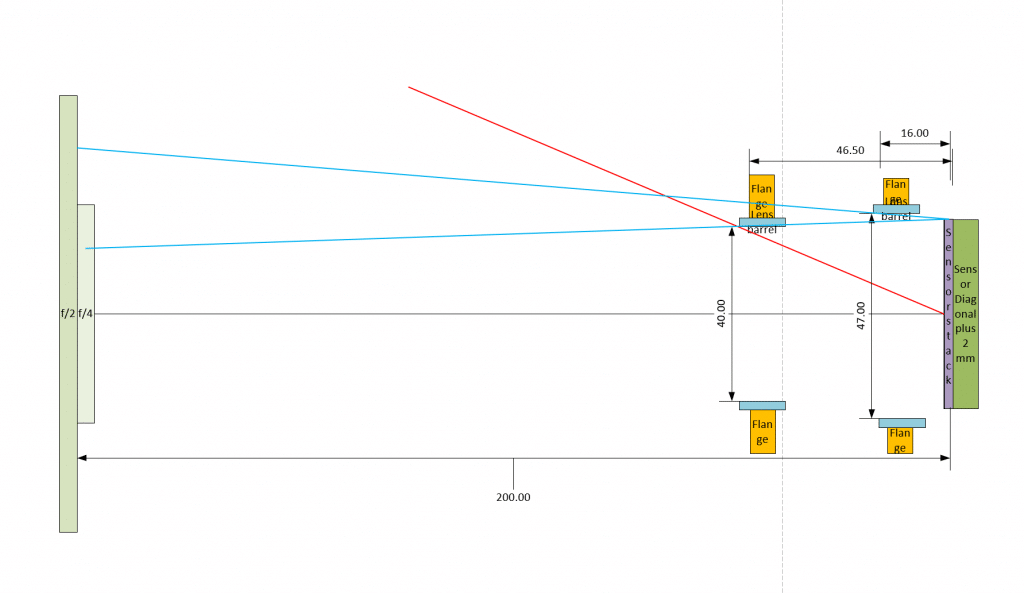Some have said that the New Nikon Z mount makes things better only for short lenses, and affords no advantage for long ones. In order to test that, I constructed the following model:
We are looking at the diagonal of the sensor, which is 42.3 mm. In order to get the opening available for the passage of light, I measured several Nikon F-mount lenses whose rear elements ended well outside of the flange (well, outside as viewed from the sensor; if you were looking at it from the perspective of the lens, the rear elements were well inside the lens). The lenses had light stops and space for contacts, so the openings weren’t round. I used size in the sensor diagonal direction. That gave me a diameter 4 mm smaller than the mount throat. I assumed the same reduction to get the clear opening for the Z mount lenses, since I don’t yet have one.
I then made an unrealistic assumption: that the long lens is a simple one, with a single symmetric element. Thus the exit pupil of the lens its focal length from the sensor when the lens is focused at infinity, and light travels in a straight line between the exit pupil and the sensor. I drew in the exit pupils for a 200 mm f/2 and a 200 mm f/4 lens.
Then I constructed some lines. The red one is from the center of the sensor to the diagonal extent of the F mount. The center of the sensor can clearly see the whole image circle. The clear opening is smaller in the horizontal and vertical directions, but there’s so much room here that those dimensions aren’t going to be a problem for the 200 mm f/2 case. Had I constructed the same line for the Z mount, it would be even more generous.
The problems start when we start to consider whether the corners of the sensor can see the whole exit pupil. Look at the blue lines. In the case of the F mount, the corners can’t even see the whole exit pupil of an f/4 200 mm lens. The Z mount can handle that, but can’t see the whole f/2 exit pupil.
The consequences of not being able to see the entirety of the exit pupil are darkening in the periphery of the image, and non-circular out-of-focus point spread functions off axis. We are used to both of those. The former is common in shorter focal length lenses where the light ray bundles impinge on the periphery of the sensor at significantly off-vertical angles. The latter often occurs when off-axis light is blocked inside the lens, before it ever gets to the mount. Neither is the end of the world.
Most long-focus lenses have negative elements towards the camera end, so in real life the effects won’t be as bad as what I show in the diagram above.

Mike Nelson Pedde says
This is probably a stupid question, but since an F-mount lens can only mount to a Z-mount camera with an adapter, did you guestimate the the thickness of the adapter from those you already own?
JimK says
If the F-mount FFD is 46.5 mm and the Z mount FFD is 16 mm, then the adapter has to be 30.5 mm flange to flange. Unless it’s deliberately too short to allow lenses to focus to infinity in the face of tolerance buildup.
Mike Nelson Pedde says
Thx!!
syberman7 says
This is called ‘mechanical vignetting’.